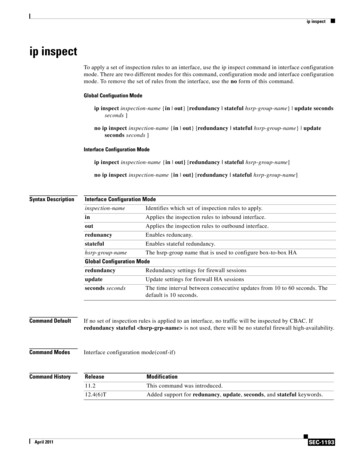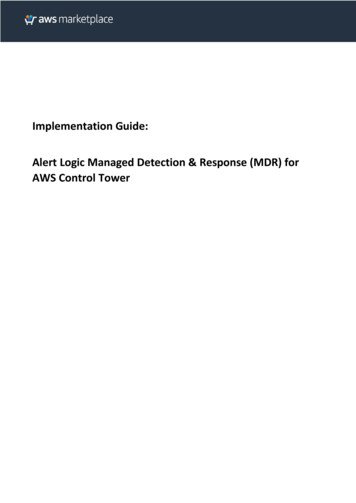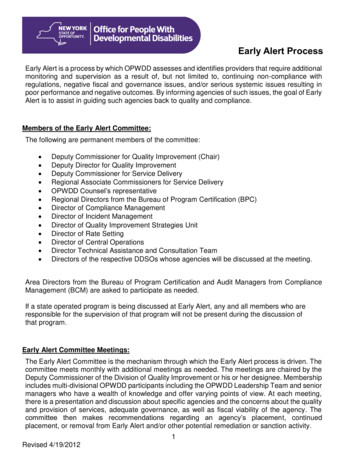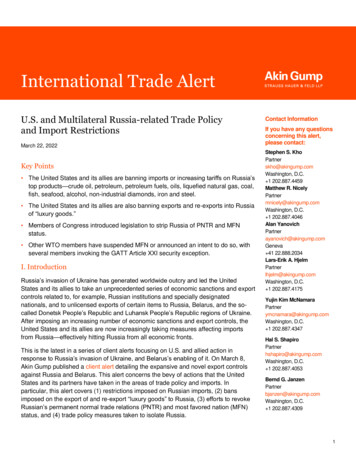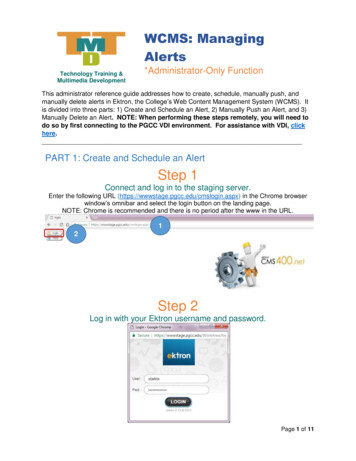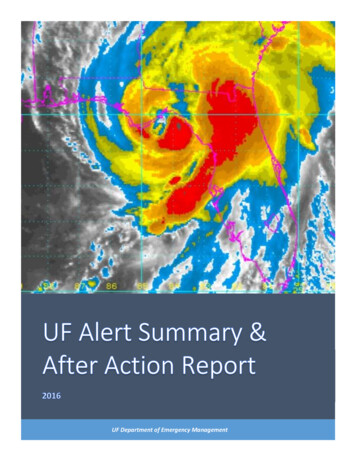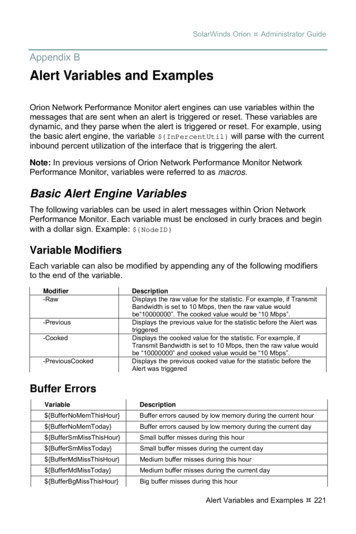
Transcription
SolarWinds Orion Administrator GuideAppendix BAlert Variables and ExamplesOrion Network Performance Monitor alert engines can use variables within themessages that are sent when an alert is triggered or reset. These variables aredynamic, and they parse when the alert is triggered or reset. For example, usingthe basic alert engine, the variable {InPercentUtil} will parse with the currentinbound percent utilization of the interface that is triggering the alert.Note: In previous versions of Orion Network Performance Monitor NetworkPerformance Monitor, variables were referred to as macros.Basic Alert Engine VariablesThe following variables can be used in alert messages within Orion NetworkPerformance Monitor. Each variable must be enclosed in curly braces and beginwith a dollar sign. Example: {NodeID}Variable ModifiersEach variable can also be modified by appending any of the following modifiersto the end of the edDescriptionDisplays the raw value for the statistic. For example, if TransmitBandwidth is set to 10 Mbps, then the raw value wouldbe“10000000”. The cooked value would be “10 Mbps”.Displays the previous value for the statistic before the Alert wastriggeredDisplays the cooked value for the statistic. For example, ifTransmit Bandwidth is set to 10 Mbps, then the raw value wouldbe “10000000” and cooked value would be “10 Mbps”.Displays the previous cooked value for the statistic before theAlert was triggeredBuffer ErrorsVariableDescription {BufferNoMemThisHour}Buffer errors caused by low memory during the current hour {BufferNoMemToday}Buffer errors caused by low memory during the current day {BufferSmMissThisHour}Small buffer misses during this hour {BufferSmMissToday}Small buffer misses during the current day {BufferMdMissThisHour}Medium buffer misses during this hour {BufferMdMissToday}Medium buffer misses during the current day {BufferBgMissThisHour}Big buffer misses during this hourAlert Variables and Examples 221
Administrator Guide SolarWinds OrionVariableDescription {BufferBgMissToday}Big buffer misses during the current day {BufferLgMissThisHour}Large buffer misses during this hour {BufferLgMissToday}Large buffer misses during the current day {BufferHgMissThisHour}Huge buffer misses during this hour {BufferHgMissToday}Huge buffer misses during the current dayInterfacesVariableDescription {InterfaceID}Unique ID of the interface. Network Performance Monitorassigns a unique ID to every network object. {InterfaceCaption}User-assigned name for this interface {Index}Index of the interface within the network node. {InterfaceType}Numerical type of the interface. This information is collected byNetwork Performance Monitor when discovering the networknode. {Description}Description of the interface. {MAC}Physical address (MAC Address) of the interface {MTU}Maximum Transmission Unit {InterfaceSpeed}Speed of the Interface discovered by Network PerformanceMonitor when scanning the network node {InterfaceName}Name of the interface discovered from the node {InterfaceIcon}Icon depicting the type of interface (Ethernet, Frame-Relay,ATM, Token Ring, wireless, etc). {NodeID}ID of the Network Node to which this interface belongs. NetworkPerformance Monitor assigns a unique ID to every networkobject. {InterfaceTypeName}Type of interface. Discovered from ifType. {FullName}Full name of the interface including the name of the networknode it is in {Counter64}Interface supports IF-MIB high-capacity counters222 Alert Variables and Examples
SolarWinds Orion Administrator GuideInterface ErrorsVariableDescription {InDiscardsToday}Cumulative number of receive discards for this interface today {InErrorsToday}Cumulative number of receive errors for this interface today {OutErrorsToday}Cumulative number of transmit errors for this interface today {OutDiscardsToday}Cumulative number of transmit discards for this interface today {InDiscardsThisHour}Cumulative number of receive discards for this in {InErrorsThisHour}Cumulative number of receive errors for this interface this hour(this counter resets at the top of the hour) {OutErrorsThisHour}Cumulative number of transmit errors for this interface thishour (this counter resets at the top of the hour) {OutDiscardsThisHour}Cumulative number of transmit discards for this interface thishour (this counter resets at the top of the hour)Interface StatusVariableDescription {LastChange}Last date and time the interface changed operational status {AdminStatus}Administrative status of the interface (enabled or disabled) {OperStatus}Operational status of the interface {AdminStatusLED}LED showing current administrative status of the interface(enabled or disabled) {OperStatusLED}LED showing current operational status of the interface {Status}Current status of the interface (up, down, shut down, etc.) {StatusLED}Current status of the interface (up, down, shut down, etc.)Interface PollingVariableDescription {PollInterval}How often the interface should be polled (in seconds) {RediscoveryInterval}How often the node/interface should be rediscovered (inminutes) {NextRediscovery}Scheduled time for the next complete discovery of this interface {NextPoll}Scheduled time for next poll of this interface {StatCollection}Frequency of statistics collectionAlert Variables and Examples 223
Administrator Guide SolarWinds OrionInterfaces (CATV version only)VariableDescription {SignalNoise}Signal/Noise ratio for this interface in db. {MinSignalNoise}Minimum signal/noise ratio over the last few polls {MaxSignalNoise}Maximum signal/noise ratio over the last few polls {AvgSignalNoise}Average Signal/Noise ratio of the interface. This iscalculated from the last 10 polls of the interface. {PercentCodewordsUnerrored}Percent of code words received by the interfacewithout errors. {PercentCodewordsCorrected}Percent of code words received by the interface thathad correctable errors. {PercentCodewordsUnCorrectedPercent of code words received by the interface thathad errors and could not be corrected. {CodewordsUnerrored}Current number of code words received withouterrors by the interface. {CodewordsCorrected}Current number of code words received by theinterface that had errors, but could be corrected. {CodewordsUncorrectable}Current number of code words received by theinterface that had errors, but could not be corrected. {TotalCodewords}Total number of code words received by theinterface224 Alert Variables and Examples
SolarWinds Orion Administrator GuideInterface TrafficVariableDescription {OutBandwidth}User-defined transmit bandwidth of the Interface. The Transmitand Receive bandwidth can each be set independently in orderto accurately monitor asymmetric circuits. {OutBps}Current amount of traffic being transmitted by the interface {InBps}Current amount of traffic being received by the interface {OutPps}Current rate of transmitted packets per second by the interface {InPps}Current rate of received packets per second by the interface {InPktSize}Average packet size of the packets currently being received bythe interface {OutUcastPps}Current rate of transmitted unicast packets per second {OutMCastPps}Current rate of transmitted multicast packets per second {InUcastPps}Current rate of received unicast packets per second {InMcastPps}Current rate of received multicast packets per second {OutPktSize}Average packet size of the packets currently being transmittedby the interface {InPercentUtil}Current percentage of utilization on the receive side of theinterface {OutPercentUtil}Current percentage of utilization on the transmit side of theinterface {MaxInBpsToday}Peak received bps today for the interface {MaxOutBpsToday}Peak transmitted bps today for the interface {MaxInBpsTime}Time (today) of the peak bps received {MaxOutBpsTime}Time (today) of the peak bps transmitted {InBandwidth}User-defined receive bandwidth of the Interface. The Transmitand Receive Bandwidth can each be set independently in orderto accurately monitor asymmetric circuits.Alert Variables and Examples 225
Administrator Guide SolarWinds OrionNodesVariableDescription {NodeID}Unique ID automatically assigned to each node {IP}IP Address of the node. This is the IP address that is used for allmanagement functions. {NodeName}User assigned name for this node {SysName}System name of the node {DNS}DNS name determined using a reverse DNS lookup. The DNSentry is checked during rediscovery of the network node. {SysObjectID}Unique identifier assigned to this node by the manufacture {Vendor}The manufacture of the network node {Location}Location retrieved from the system MIB {Contact}System Contact. This information is collected by NetworkPerformance Monitor when discovering the network node. {Description}System description of the node. This information is collected byNetwork Performance Monitor when discovering the networknode. {LastBoot}Date and time the machine last booted {Community}SNMP community string used to communicate with this node {VendorIcon}Icon depicting the type of machine {IOSImage}Cisco IOS image family type {IOSVersion}Cisco IOS version {MachineType}The machine type or manufacture of the network nodeNode PollingVariableDescription {RediscoveryInterval}How often the node should be rediscovered (in minutes) {NextRediscovery}Date and time of next rediscovery {PollInterval}How often the node/interface should be polled. (in seconds) {NextPoll}Scheduled time for the next poll of the node/interface {StatCollection}Frequency of statistics collection226 Alert Variables and Examples
SolarWinds Orion Administrator GuideNode StatisticsVariableDescription {ResponseTime}Current response time of the node in milliseconds {PercentLoss}Percent packet loss over the last few minutes. Packet loss iscalculated from the number of ICMP packets that are droppedwhen polling the node. {AvgResponseTime}Average response time for the node over the last few minutes {MinResponseTime}Shortest response time over the last few minutes {MaxResponseTime}Longest response time over the last few minutes {CPULoad}Percentage of CPU usage {TotalMemory}Total RAM reported in node {MemoryUsed}Total RAM in allocated in node {PercentMemoryUsed}Percentage of used RAM to total RAMNode StatusVariableDescription {Status}Current status of the node. (up, down, warning, etc) {StatusLED}Current status icon of the node {GroupStatus}Current status icon of the Node and all its interfaces (Up, Down,Warning, etc) {StatusDescription}Current status of the Node and its interfaces. {Severity}Severity Status of the Node and its InterfacesObject TypesVariableDescription {ObjectType}Type of network object {ObjectSubtype}Subtype of the network objectVolumesVariableDescription {NodeID}ID of the network node to which this volume belongs. NetworkPerformance Monitor assigns a unique ID to every networkobject. {VolumeID}Unique ID of the volume. Network Performance Monitor assignsa unique ID to every network object. {Caption}User-assigned name for this volume {VolumeIndex}Index of the volume within the Network Node {VolumeType}Type of volume. Discovered from hrStorageTypeAlert Variables and Examples 227
Administrator Guide SolarWinds OrionVariableDescription {VolumeDescription}Description of the volume {FullName}Full name of the volume including the name of the NetworkNode it is in.Volume PollingVariableDescription {PollInterval}How often the volume should be polled {StatCollection}Frequency of statistics collection {NextPoll}Scheduled time for next poll of this volume {RediscoveryInterval}Rediscovery Interval of this Volume {NextRediscovery}Scheduled time for the next complete discovery of this volume.Volume StatisticsVariableDescription {VolumeSize}Volume size in bytes {VolumeSpaceUsed}Total bytes used on volume {VolumePercentUsed}Percentage of volume used as discovered bySNMP {VolumeAllocationFailuresThisHour}Number of volume allocation errors this hour {VolumeAllocationFailuresToday}Number of volume allocation errors todayVolume StatusVariableDescription {Status}Current status of the volume (up, down, shut down, etc.) {StatusLED}Current status of the volume (up, down, shut down, etc.) {VolumeResponding}Indicates whether of not the volume is currently responding toSNMP queries228 Alert Variables and Examples
SolarWinds Orion Administrator GuideDate/TimeVariableDescription {DateTime}Current date and time. (Windows control panel defined “ShortDate” and “Short Time” format) {Date}Current date. (Short Date format) {LongDate}Current date. (Long Date format) {MediumDate}Current date. (Medium Date format) {Time}Current Time. (Short Time format) {DayOfWeek}Current day of the week. {D}Current day of the month {DD}Current day of the month (two digit number, zero padded) {AbreviatedDOW}Current day of the week. Three character abbreviation. {LocalDOW}Current day of the week. Localized language format. {M}Current month {MM}Current month. Two digit number, zero padded. {MMM}Current month. Three character abbreviation. {MMMM}Full name of the current month {LocalMonthName}Current month name in the local language. {DayOfYear}Numeric day of the year {Year2}Two digit year {Year}Four digit year {H}Current hour {HH}Current hour. Two digit format, zero padded. {M}Current minute {Minute}Current minute. Two digit format, zero padded. {S}Current second. {Second}Current second. Two digit format, zero padded. {AMPM}AM/PM indicatorAlert Variables and Examples 229
Administrator Guide SolarWinds OrionAlert SpecificVariableDescription {AlertName}Name of the Alert {Property}Property that this Alert is monitoring {TriggerTime}Date and time of the last event for this Alert. (Windows controlpanel defined “Short Date” and “Short Time”) {LastResetTime}Date and time of the last event for this Alert. (Windows controlpanel defined “Short Date” and “Short Time”) {LongTriggerTime}Date and time of the last event for this Alert. (Windows controlpanel defined “Medium Date” and “Medium Time”) {LongLastResetTime}Date and time of the last event for this Alert. (Windows controlpanel defined “Medium Date” and “Medium Time”) {TriggeredValue}Value that triggered the Alert {AlertStartTime}Time of day that the Alert is active and can be Triggered/Reset {AlertEndTime}Time of day that the Alert is active and can be Triggered/ResetExample Messages Using VariablesThe following examples illustrate some of the uses of variables. Interface {FullName} has changed from {Status-Previous} to {Status} {FullName} rebooted at {LastBoot}. Previous reboot was at {LastBoot-Previous}. Interface {Caption} on {NodeName} is {Status}. Thisindicates a problem with this network segment that should beinvestigated. This problem was identified at {DateTime}. Alert: {NodeName} has exceptionally high response time.Average Response Time is {AvgResponseTime} and is varying from {MinResponseTime} to {MaxResponseTime}. Alert: Percent Utilization of {Fu1lName} is above {OutPercentUtil}. Current traffic load on this interface is {InBps} Received and {OutBps} Transmitted. Signal-to-Noise ratio on {NodeName}- {InterfaceName} isabnormal and may indicate deteriorating RF quality on thisinterface. Average Signal/Noise Ratio on this interface is currently {AvgSignalNoise} and is varying between {MinSignalNoise} and {MaxSignalNoise}. Instantaneous Signal/Noise ratio at this time is {SignalNoise}.230 Alert Variables and Examples
SolarWinds Orion Administrator Guide Alert: The Percent of received code words without error by {Fu1lName] is {%CodewordsUnErrored}. This may indicatedeteriorating RF quality on this interface. Percent correctablecode words is {%CodewordsCorrectable}. Percent Uncorrectablecode words is {%CodewordsUnCorrectable}. Current packet loss for {NodeName} is {%Loss}. AverageResponse time is {AvgResponseTime} and is varying from {MinResponseTime} to {MaxResponseTime}. Alert: The SNMP Community string used to query {NodeName} hasbeen changed from {Community-Previous} to {Community}. Network Performance Monitor will use the new SNMP CommunityString when querying {NodeName}.Basic Alert Engine Suppression ExamplesMany error conditions can occur in a network that will trigger multiple alerts froma single causal event. There are also conditions that may not need to trigger analert by themselves but that should trigger alerts if they occur with otherconditions. Options under the Alert Suppression tab allow you to set upconditions that consider complex situations and alert you with the information thatyou need in order to determine the root cause of the problem.By default, alert suppression is not configured, and is thus not active. There aretwo choices for activating alert suppression when using the basic alert engine.You may specify that alerts be suppressed:1. if any of one or more conditions exist, or2. if all of two or more conditions exist.Note: You should proceed with extreme care when configuring the alertsuppressions as it is possible to suppress alerts that contain importantinformation about the status of your network. SolarWinds suggests that you giveconsiderable thought to your alert suppression scheme, developing a diagram ofyour network and extensively testing any scenario in which you intend to applyalert suppression.Alert Variables and Examples 231
Administrator Guide SolarWinds OrionExamples of situations for which you might want to create alert suppressions areillustrated in the following diagram.Note: The Orion Network Performance Monitor Server is located on Switch 2, atthe top right of the diagram.Failure of redundant serversIn the diagram above, both WServers are identical in order to providefailover, redundancy, and load balancing. If WServer4 fails but WServer5 isstill functioning, you may want to be alerted immediately if the failure occursduring business hours, though it might not justify a page in the middle of thenight. In this case, you would configure the alert for the failure of oneWServer to be suppressed unless the other also fails.Apparent failure of dependent nodes downstream of a failed router (orswitch, or circuit)In the diagram above there are dependencies among devices. For instance,if Router C fails, the Orion Server will be unable to reach Switch 3 and allfour workstations. You will want to know if and when the workstations havefailed, but only if Router C and Switch 3 have not failed. You would configurethe alerts such that a failure alert for the workstations is dependent on RouterC and Switch 3 being operational.Failure of a network link when a redundant link is still functionalDuring some hours, you may only want to be notified of the failure of the linkbetween Router B and Router C if the alternative link through Router A isalso down.232 Alert Variables and Examples
SolarWinds Orion Administrator GuideFailure of load balancing between devicesYou may have configured your network to balance traffic across your webservers. In this case, you could configure an alert that notifies you of veryhigh CPU utilization on any one of the servers but only if one or more isexperiencing much lower usage.Note: In any case, the suppression of alerts does not preclude knowledge ofcritical events. Network events will be logged in the database whether alertsuppression is enabled or not.Dependent Node Alert Suppression ExampleSuppose that you have just configured an alert that notifies you when nodes on asubnet go down. In this case, the workstations are on a segment of your networkon the other side of a particular router. You only want to be alerted to nodefailures if the router is still operational.Note: For this example, the router should not be included in the group ofmonitored objects, since its failure is the trigger for suppressing the alert. To benotified of router failure, you must set up another alert.To configure a dependant node alert suppression:1. Click Start All Programs SolarWinds Orion System Manager.2. Click Alerts Configure Basic Alerts.3. Click New Alert.4. Click General, enter a name for your alert, and then check Enable this Alert.5. Click Property to Monitor.Alert Variables and Examples 233
Administrator Guide SolarWinds Orion6. Check Node Status Status.Note: Select only one property from those that are available.7. Click Monitored Network Objects, and then select the workstations that areon the segment of your network that is on the other side of the router.8. Click Alert Trigger.9. Check Trigger Alert when Status is Unknown, Down, and Warning.10. Check Reset Alert when Status is Up.11. Click Alert Suppression, and then select Suppress this alert if ANY of theselected suppressions are active.Note: The window opens to display a list of current suppressions, if anyexist, and buttons that you can use to add, edit, and delete conditions.12. Click Add.13. Click Property to Monitor.14. Select Node Status Status.Note: Select only one property from those that are available.15. Click Network Object, and then select the router that stands between OrionNetwork Performance Monitor and the subnet for which you have configuredthe node down alert.Note: The type of objects available for monitoring depends upon the choicethat you made in the Properties to Monitor tab. If you had chosen to monitoran interface-related property, you would see a list of available interfaces.Since you’ve chosen a node-related property, you will see a list of nodes.16. Click Suppression Trigger, check Down, Warning, and Unknown on the tab,and then click OK.Note: For status conditions, you may specify more than one condition.17. Check the suppressions that you want to apply in order to enable them.Note: By default, suppressions are not turned on.18. If you want to add more conditions, repeat this procedure, by clicking Addto begin again.234 Alert Variables and Examples
SolarWinds Orion Administrator GuideFailure of Load Balancing AlertIf you have multiple servers configured to share the load on your website, you willwant to know if one of them is not performing as it should. For the purposes ofthis example, we’ll assume that you want to be alerted when the CPU load ontwo servers exceeds 80 percent, but only if one shows a CPU load of 40 percentor less. In other words, the alert is suppressed if the second server reportsgreater than 40 percent utilization, as shown in the diagram.You will need to configure two alerts, one for each server. They will be identical,except for the server that each alert monitors. Proceed to follow these steps toconfigure these alerts. For more information, see “Creating and Manag” onpage 41.To configure a load balancing failure alert:1. Click Start All Programs SolarWinds Orion System Manager.2. Click Alerts Configure Basic Alerts.3. Click New Alert.4. Click General, enter a name for your alert, and then check Enable this Alert.5. Click Property to Monitor, and then check Node Statistics % CPUUtilization.6. Click Monitored Network Objects, and then check the server that you want tomonitor.7. Click Alert Trigger.8. Select a condition to Trigger Alert when % CPU Utilization, and then enterthe trigger value: Trigger Value 80% for our example.9. Select a condition to Reset Alert when % CPU Utilization, and then enterthe reset value: Reset Value 80% for our example.Alert Variables and Examples 235
Administrator Guide SolarWinds Orion10. If you want to set timeframe parameters, use the Time of Day tab.11. Click Alert Suppression, and then select Suppress this alert if ANY of theselected suppressions are active.Note: Any previously configured alerts will be listed, unchecked.12. Click Add.13. Click Property to Monitor, and then check Node Statistics % CPUUtilization.14. Click Network Object, and check the second server of the pair whose loadshould be balanced.15. Suppression Trigger, select Greater Than, type 40 in the text-entry field, andthen click OK.16. Check the suppression that you just defined to activate it.17. Repeat the procedure, reversing the server choices made for alerting andsuppression.Advanced Alert Engine VariablesThe following variables can be used in alert messages within Orion NetworkPerformance Monitor applications. You must begin each variable with a dollarsign and enclose each variable identifier in curly braces as, for example, {ObjectName}.GeneralThe following are valid, general advanced alert variables.General VariableDescription {Acknowledged}Acknowledged status {AcknowledgedBy}Who the alert was acknowledged by {AcknowledgedTime}Time the alert was acknowledged {AlertTriggerCount}Count of triggers {AlertTriggerTime}Date and time of the last event for this Alert. (Windows controlpanel defined “Short Date” and “Short Time”) {Application}SolarWinds application information {CR}Line Feed – Carriage Return {Copyright}Copyright information {ObjectName}Description/Name of the object in the alert {Release}Release information {Version}Version of the SolarWinds software package236 Alert Variables and Examples
SolarWinds Orion Administrator GuideCustom MIB PollerThe following are valid custom MIB poller variables.Custom MIB Poller VariableDescription {DateTime}Date/Time {Description}Description of the Custom MIB Poller {Enabled}Enabled status of the Custom MIB Poller {MIB}MIB {OID}OID {Rate}Rate {Status}Status {Total}Total {UniqueName}Name of the Custom MIB PollerDate/TimeThe following are valid date and time variables.Date/Time VariableDescription {AMPM}AM/PM indicator {AbreviatedDOW}Current day of the week. Three character abbreviation. {D}Current day of the month {DD}Current day of the month (two digit number, zero padded) {Date}Current date. (Short Date format) {DateTime}Current date and time. (Windows control panel defined “ShortDate” and “Short Time” format) {DayOfWeek}Current day of the week. {DayOfYear}Numeric day of the year {H}Current hour {HH}Current hour. Two digit format, zero padded. {Last2Hours}Last two hours {Last24Hours}Last 24 hours {Last7Days}Last seven days (Short Date format) {LastHour}Last hour {LocalDOW}Current day of the week. Localized language format. {LocalMonthName}Current month name in the local language. {LongDate}Current date. (Long Date format) {M}Current month {MM}Current month. Two digit number, zero padded. {MMM}Current month. Three character abbreviation.Alert Variables and Examples 237
Administrator Guide SolarWinds OrionDate/Time VariableDescription {MMMM}Full name of the current month {MediumDate}Current date. (Medium Date format) {Minute}Current minute. Two digit format, zero padded. {S}Current second. {Second}Current second. Two digit format, zero padded. {Time}Current Time. (Short Time format) {Today}Today (Short Date format) {Year}Four digit year {Year2}Two digit year {Yesterday}Yesterday (Short Date format)SQL QueryAny value that you can collect from the database can be generated, formatted, orcalculated using a SQL query as a variable. To use a SQL query as a variable,use {SQL:{query}} as follows: {SQL:Select Count(*) From Nodes}Node Status VariablesWhen using the {Status} variable with a node, numeric values are returned.The following table provides a description for each numeric value.Numeric ValueDescription {0}Unknown {1}Up {2}Down {3}Warning {4}Shutdown {5}Testing {6}Dormant {7}NotPresent {8}LowerLayerDown {9}Unmanaged238 Alert Variables and Examples
SolarWinds Orion Administrator GuideCustom Interface Poller VariablesThe following are valid custom interface poller variables.Note: At least one of the CustomPollerStatus variables from the tables belowmust be included in the trigger condition of all Custom Interface Poller alerts.Custom Interface PollerAssignment VariableDescription {AssignmentName}User friendly name of a specific assignment in theform: PollerName - NodeName InterfaceName . Interface name is '0' if this is a nodepoller {CustomPollerAssignmentID}Internal unique ID (as guid) of specific assignment ofa custom poller to a node or interface. {InterfaceID}Internal unique ID of interface (as integer) in thisassignment. '0' if this is a node poller {NodeID}Internal unique ID of node (as integer) in thisassignment {PollerID}Internal unique ID of poller (as guid) in this specificassignmentCustom Interface PollerStatus VariableDescription {CustomPollerAssignmentID}Internal unique ID (as guid) of the specific assignment of acustom poller to a node or interface. {DateTime}Date and time statistic was last collected for thisassignment {DateTimeUTC}Date and time statistics were last collected for thisassignment (universal time) {Rate}For a custom poller with a MIB value type of 'Rate', thisfield contains numeric data collected from the OID. For acustom poller with a MIB value type of 'Counter', this fieldcontains the change in the previous value as normalizedto the polling interval. For a custom poller with a MIB valueof 'Raw Value' this field is null. {RawStatus}For custom poller with a MIB value type 'Rate' or'Counter', this field is null. For custom poller with MIBvalue 'Raw Value' and an OID response value that isnumeric, this field contains the numeric value. For acustom poller with MIB value 'Raw Value' and an OIDresponse value that is not numeric, this field is null. Forenumerations this field contains the actual numeric valuereturned from the OID instead of the user friendly text.Status comparisons that are numeric (greater than andless than) should use this field. Status values that are textdescriptions should use the 'Status' field.Alert Variables and Examples 239
Administrator Guide SolarWinds OrionCustom Interface PollerStatus VariableDescription {Status}For a custom poller with a MIB value type of 'Rate' or'Counter', this field is null. For a custom poller with a MIBvalue of 'Raw Value' this field contains the value from theOID 'cooked' according to its sub-type. Enumerationscontain user friendly text instead of a numeric valuereturned from the OID.
In previous versions of Orion Network Performance Monitor Network Performance Monitor, variables were referred to as . macros. Basic Alert Engine Variables . The following variables can be used in alert messages within Orion Network Performance Monitor. Each variable must be enclosed in curly braces and begin with a dollar sign. Example: {NodeID}

